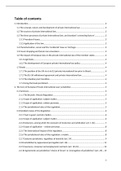Resume
Samenvatting Private International Law KUL - 16/20 eerste zit
- Établissement
- Katholieke Universiteit Leuven (KU Leuven)
Samenvatting o.b.v. ppts, lesnotities en (in beperkte mate, nl. wat in de les werd besproken) de cursus. De inleiding is samen te lezen met de samenvatting van de prof (skeleton document, zie toledo). De inhoudsopgave loopt volgens de cursus. 16/20 behaald in eerste zit.
[Montrer plus]




